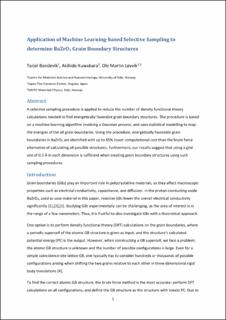| dc.contributor.author | Bondevik, Tarjei | |
| dc.contributor.author | Kuwabara, Akihide | |
| dc.contributor.author | Løvvik, Ole Martin | |
| dc.date.accessioned | 2020-11-25T08:50:48Z | |
| dc.date.available | 2020-11-25T08:50:48Z | |
| dc.date.created | 2019-06-18T09:08:24Z | |
| dc.date.issued | 2019 | |
| dc.identifier.citation | Computational materials science. 2019, 164 57-65. | en_US |
| dc.identifier.issn | 0927-0256 | |
| dc.identifier.uri | https://hdl.handle.net/11250/2689474 | |
| dc.description.abstract | A selective sampling procedure is applied to reduce the number of density functional theory calculations needed to find energetically favorable grain boundary structures. The procedure is based on a machine learning algorithm involving a Gaussian process, and uses statistical modelling to map the energies of the all grain boundaries. Using the procedure, energetically favorable grain boundaries in BaZrO3 are identified with up to 85% lower computational cost than the brute force alternative of calculating all possible structures. Furthermore, our results suggest that using a grid size of 0.3 Å in each dimension is sufficient when creating grain boundary structures using such sampling procedures. | en_US |
| dc.language.iso | eng | en_US |
| dc.publisher | Elsevier | en_US |
| dc.rights | Attribution-NonCommercial-NoDerivatives 4.0 Internasjonal | * |
| dc.rights.uri | http://creativecommons.org/licenses/by-nc-nd/4.0/deed.no | * |
| dc.subject | Bayesian optimization | en_US |
| dc.subject | Gaussian Process | en_US |
| dc.subject | Grain boundary structure | en_US |
| dc.subject | Density functional theory | en_US |
| dc.title | Application of machine learning-based selective sampling to determine BaZrO3 grain boundary structures | en_US |
| dc.type | Peer reviewed | en_US |
| dc.type | Journal article | en_US |
| dc.description.version | acceptedVersion | en_US |
| dc.rights.holder | This is the authors' accepted manuscript and this is made available under the Creative Commons license Attribution-NonCommercial-NoDerivatives 4.0 International (CC BY-NC-ND 4.0). Link to the published article: https://doi.org/10.1016/j.commatsci.2019.03.054 | en_US |
| dc.source.pagenumber | 57-65 | en_US |
| dc.source.volume | 164 | en_US |
| dc.source.journal | Computational materials science | en_US |
| dc.identifier.doi | 10.1016/j.commatsci.2019.03.054 | |
| dc.identifier.cristin | 1705504 | |
| dc.relation.project | Norges forskningsråd: 228355 | en_US |
| cristin.unitcode | 7401,80,62,0 | |
| cristin.unitname | Bærekraftig energiteknologi | |
| cristin.ispublished | true | |
| cristin.fulltext | postprint | |
| cristin.qualitycode | 2 | |

